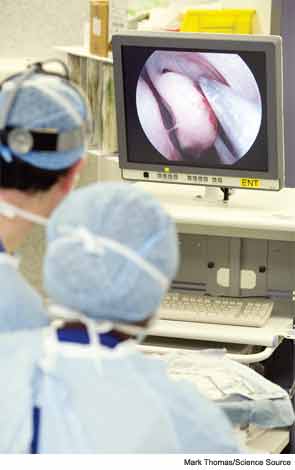
Explore This Issue
March 2013SCOTTSDALE, Ariz.—An endoscopic approach to sinonasal malignant tumors is coming into its own, but the literature on the topic is still lacking and physicians must recognize its limitations, said a panel of experts here on Jan. 25 at the Triological Society’s Combined Sections Meeting.
A new era might be dawning on the removal of these malignancies, said Marc Rosen, MD, associate professor of otolaryngology/head and neck surgery at Thomas Jefferson University Hospitals in Philadelphia. “With the combination of the bicoronal approach with the endoscope [the open endoscopic or cranioendoscopic approach], I really think that this could be the end of open facial incisions such as lateral rhinotomy and midface de-gloving for the treatment of sinonasal malignancies,” he said.
The endoscopic approach might allow for better margins due to current technology, including better illumination, magnification, panoramic view and navigation, he said. But, he stressed that it’s still not a surgery meant for the “casual” operator. “We typically have a multi-disciplinary approach with neurosurgery and ophthalmology (during the procedure) to improve outcomes,” he said. He added that surgeons should have a strong background in both head and neck cancer surgery and rhinology.
Review of the Evidence
Peter Hwang, MD, professor and director of the Stanford Sinus Center in Stanford, Calif., said that, in the end, the literature sorts out what is “a surgical fad” and what is a “durable shift in practice.” The problem is that the literature now is filled with studies that include many different tumor types, without much data for each type. And the tumors tend to be smaller in endoscopic approaches, making comparisons with an open approach, which generally involves larger tumors, difficult. “This is not a mature body of literature, and I think that’s a lot of the problem we’re having right now,” Dr. Hwang said. “We’re trying to figure out what the literature says about the efficacy of endoscopic approaches.”
For instance, he said, the most comprehensive study focused on the tumor type esthesioneuroblastoma is a meta-analysis published in 2009 (Laryngoscope. 2009;119:1412-1416). The study involved 361 participants from 28 studies. But, there was an unequal distribution of tumor stages—to a statistically significant degree—between the endoscopic and open approaches. “So definitive conclusions are therefore not possible from this, the highest level of evidence for esthesioneuroblastoma,” he said.
At this time, he added, there’s no evidence to suggest that endoscopic approaches are superior to open approaches in terms of oncologic control. “We definitely need more data to compare outcomes for advanced-stage tumors,” he said. “Ideally, we would like to see tumor-specific, stage-specific comparisons collected prospectively in order to validate the endoscopic approach to sinonasal malignancy. Once we can establish the equivalency on an oncologic basis, then we may see some differentiation based on quality of life outcomes between endoscopic and open approaches.”
Leave a Reply